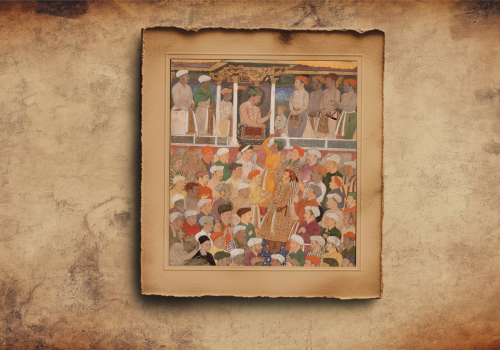TUZUKIJAHANGlRI is one of the several titles under which autobiographical writing of the Mughal Emperor, Jahangir (160527), is available, the common and generally accepted ones being TuzukiJahangin, Waqi`atiJahangm, and Jahangir Namah. The TuzukiJahangni based on the edited text of Sir Sayyid Alimad Khan of `Aligarh is embodied in two volumes translated by Alexander Rogers, revised, collated and corrected by Henry Beveridge with the help of several manuscripts from the India Office Library, British Library, Royal Asiatic Society and other sources. The first volume covers the first twelve years, while the second deals with the thirteenth to the nineteenth year of the reign. The material pertaining to the first twelve of the twentytwo regnal years, written by the Emperor in his own han
AHWAL-I-DINA BEG KHAN , Persian manuscript of unknown authorship, gives biographical details about Adina Beg Khan, faujdar of Jalandhar. The manuscript forms part of the collection of Persian Manuscripts, Sir H.Elliot\'s Papers, Additional MS. 30780 (ff. 2152-92), Extracts relating to India, vol. VIII. 1 , preserved in British Library, London. Copies of the manuscript are also held by Panjab University Library, Lahore, Sikh Historical Research Department, Khalsa College, Amritsar, and Dr Ganda Singh Collection at Punjabi University, Patiala (25 pages in neat and clear handwriting).
VAR AMRITSAR KI, also known as Var Singhan Ki, by Darshan Bhagat, a disciple of Bhai Kanhaiya is an eyewitness account of the battle fought in Amritsar between a force sent by the Mughal satrap of Lahore and the Sikhs on the Baisakhi day (29 March) of 1709. A manuscript of the poem was held under No. 2735 in the Sikh Reference Library, Amritsar, until the library perished in 1984. A published version in the anthology tided Panjabi Varan (Kalam Mandir, Patiala) is, however, available. As a result of the conciliatory policy of Emperor Bahadur Shah, the lands attached to the Golden Temple, Amritsar, which had been earlier confiscated were restored and Sikhs were appointed by Mata Sundari, widow of Guru Gobind Singh, to administer theJ`agirat Amritsar.
AJAT SAGAR, by Surjan Das Ajat, is the religious book of the Ajatpanthi sect of the Udasis. Written in AD 1851, the only known manuscript of the work was available in the Sikh Reference Library, Amritsar, until it perished during the Blue Star action in the holy premises in 1984. The author Surjan Das (father: Bagh Singh, mother: Gulab Devi, a disciple of Sant Tahil Das who was in the Bhagat Bhagvanie sect of the Udasis, established his gaddi at Ajneval, in Gujrariwala district, now in Pakistan. Surjan Das preached the ideal of a casteless (a = without; Jat = caste) society and thus came to be called Ajat and his followers Ajatpanthi.
ANJUMANIPANJAB, founded in Lahore on 21 January 1865 by the distinguished linguist, Dr Gottlieb Wilhelm Leitner, who became successively the first principal of the Government College at Lahore and the first registrar of the University of the Panjab, was a voluntary society which aimed at the development of "vernacular literature" and dissemination of popular knowledge through this medium. Its actual activities spanned a wide range of educational forums and social issues, including encouragement of Vedic and Unani medicine, a mushaira or poetical symposium, newspaper journalism, a free public library, a system of private primary schools, lecture series and publication of literary works in Indian languages.
BAHR ULMAWWAJ (lit. stormy or tempestuous sea), also known as Akhbar us Salatin, is a comprehensive work on Muslim history divided into nine parts and 49 sections fancifully called bahr (sea) and waves (mauJ) respectively, and hence the title. Its last part divided into six sections deals with Indian Timurides (i.e. the Mughals), with an account of Nadir Shah and the Durranis down to 1796. Sir Henry Miers Elliot (1808-53) found a copy of the manuscript in the Library of the Raja of Banaras. Other copies condensed into three volumes are available in Oriental Public (Khuda Bakhsh) Library, Barikipur Patna; Preussische Staatsbibliothek, Berlin; and British Library, London.
GOSHTAN MIHARVAN JI KIAN, by Sodhi Hariji (d. 1696), is a biography of the author`s father, Sodhi Miharban, written in anecdotal style of the janam sdkhis. Biographical details, however, are sparse; the work mainly contains theological discourses of Sodhi Miharban and his interpretations of gurbdm, the sacred utterances of the Gurus. The author describes Miharban as an incarnation of Shukdeva, a mythological Hindu sage, who was reborn (as Miharban) with the sole aim of explaining the gurbdm. The exposition presented is however Hariji`s own and does not always conform to Sikh principles and beliefs.
GURUJI KE SITFAN KI KATHA, lit. katha or story of the sutan or sons of Guru (Gobind Singh), by Bhai Dunna Singh Handuria, was preserved in manuscript form under MS. No. 6045 in the Sikh Reference Library at Amritsar until the Library perished in the army assault of 1984. The poem which, on the basis of internal evidence, was composed during 1`76065, comprised 122 chhands. The poet, Bhai Dunna Singh, had been with Guru Gobind Singh`s young sons and their grandmother since they crossed the River Sarsa after the evacuation of Anandpur in 1705. He accompanied, as says the poet, up to Chamkaur Sahib, where two Sikhs, Darbari and Dhuma, of the village of Saheri took custody of the family.
JANAM SAKHI SRI GUR NANAKU SAH KI by Sant Das Chhibbar is a versified biography of Guru Nanak (1469-1539), founder of the Sikh faith, based primarily on Janam Sakhi Bhai Raid. A manuscript copy of the work is preserved in the Central Public Library, Patiala, under MS. No. 2737. This script is dated 1838 Bk/AD 1781. Two more manuscripts were preserved in the Sikh Reference Library, Amritsar, until it perished in the aimy action in 1984.A published version of the work, based on all the three manuscripts then available, has been brought out by Punjabi University, Patiala, in 1985.
- 1
- 2


